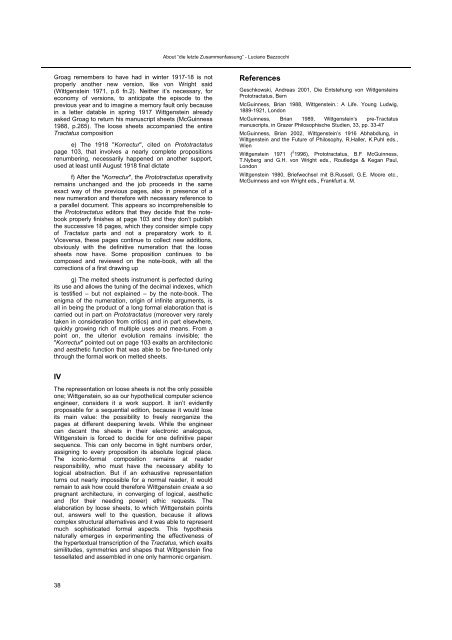Preproceedings 2006 - Austrian Ludwig Wittgenstein Society
Preproceedings 2006 - Austrian Ludwig Wittgenstein Society
Preproceedings 2006 - Austrian Ludwig Wittgenstein Society
You also want an ePaper? Increase the reach of your titles
YUMPU automatically turns print PDFs into web optimized ePapers that Google loves.
Groag remembers to have had in winter 1917-18 is not<br />
properly another new version, like von Wright said<br />
(<strong>Wittgenstein</strong> 1971, p.6 fn.2). Neither it’s necessary, for<br />
economy of versions, to anticipate the episode to the<br />
previous year and to imagine a memory fault only because<br />
in a letter datable in spring 1917 <strong>Wittgenstein</strong> already<br />
asked Groag to return his manuscript sheets (McGuinness<br />
1988, p.265). The loose sheets accompanied the entire<br />
Tractatus composition<br />
e) The 1918 "Korrectur", cited on Prototractatus<br />
page 103, that involves a nearly complete propositions<br />
renumbering, necessarily happened on another support,<br />
used at least until August 1918 final dictate<br />
f) After the "Korrectur", the Prototractatus operativity<br />
remains unchanged and the job proceeds in the same<br />
exact way of the previous pages, also in presence of a<br />
new numeration and therefore with necessary reference to<br />
a parallel document. This appears so incomprehensible to<br />
the Prototractatus editors that they decide that the notebook<br />
properly finishes at page 103 and they don’t publish<br />
the successive 18 pages, which they consider simple copy<br />
of Tractatus parts and not a preparatory work to it.<br />
Viceversa, these pages continue to collect new additions,<br />
obviously with the definitive numeration that the loose<br />
sheets now have. Some proposition continues to be<br />
composed and reviewed on the note-book, with all the<br />
corrections of a first drawing up<br />
g) The melted sheets instrument is perfected during<br />
its use and allows the tuning of the decimal indexes, which<br />
is testified – but not explained – by the note-book. The<br />
enigma of the numeration, origin of infinite arguments, is<br />
all in being the product of a long formal elaboration that is<br />
carried out in part on Prototractatus (moreover very rarely<br />
taken in consideration from critics) and in part elsewhere,<br />
quickly growing rich of multiple uses and means. From a<br />
point on, the ulterior evolution remains invisible; the<br />
"Korrectur" pointed out on page 103 exalts an architectonic<br />
and aesthetic function that was able to be fine-tuned only<br />
through the formal work on melted sheets.<br />
IV<br />
The representation on loose sheets is not the only possible<br />
one; <strong>Wittgenstein</strong>, so as our hypothetical computer science<br />
engineer, considers it a work support. It isn’t evidently<br />
proposable for a sequential edition, because it would lose<br />
its main value: the possibility to freely reorganize the<br />
pages at different deepening levels. While the engineer<br />
can decant the sheets in their electronic analogous,<br />
<strong>Wittgenstein</strong> is forced to decide for one definitive paper<br />
sequence. This can only become in tight numbers order,<br />
assigning to every proposition its absolute logical place.<br />
The iconic-formal composition remains at reader<br />
responsibility, who must have the necessary ability to<br />
logical abstraction. But if an exhaustive representation<br />
turns out nearly impossible for a normal reader, it would<br />
remain to ask how could therefore <strong>Wittgenstein</strong> create a so<br />
pregnant architecture, in converging of logical, aesthetic<br />
and (for their needing power) ethic requests. The<br />
elaboration by loose sheets, to which <strong>Wittgenstein</strong> points<br />
out, answers well to the question, because it allows<br />
complex structural alternatives and it was able to represent<br />
much sophisticated formal aspects. This hypothesis<br />
naturally emerges in experimenting the effectiveness of<br />
the hypertextual transcription of the Tractatus, which exalts<br />
similitudes, symmetries and shapes that <strong>Wittgenstein</strong> fine<br />
tessellated and assembled in one only harmonic organism.<br />
38<br />
About “die letzte Zusammenfassung” - Luciano Bazzocchi<br />
References<br />
Geschkowski, Andreas 2001, Die Entstehung von <strong>Wittgenstein</strong>s<br />
Prototractatus, Bern<br />
McGuinness, Brian 1988, <strong>Wittgenstein</strong>.: A Life. Young <strong>Ludwig</strong>,<br />
1889-1921, London<br />
McGuinness, Brian 1989, <strong>Wittgenstein</strong>’s pre-Tractatus<br />
manuscripts, in Grazer Philosophische Studien, 33, pp. 33-47<br />
McGuinness, Brian 2002, <strong>Wittgenstein</strong>’s 1916 Abhabdlung, in<br />
<strong>Wittgenstein</strong> and the Future of Philosophy, R.Haller, K.Puhl eds.,<br />
Wien<br />
<strong>Wittgenstein</strong> 1971 ( 2 1996), Prototractatus, B.F McGuinness,<br />
T.Nyberg and G.H. von Wright eds., Routledge & Kegan Paul,<br />
London<br />
<strong>Wittgenstein</strong> 1980, Briefwechsel mit B.Russell, G.E. Moore etc.,<br />
McGuinness and von Wright eds., Frankfurt a. M.












